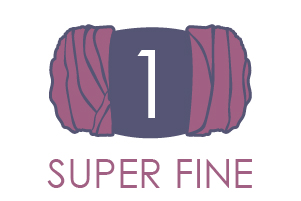
Utilizing simple hat shaping techniques, this reversible striped beret is an easy, entertaining knit. Work your first beret from the top-down using alternating stripes of natural boucle and a jewel tone fingering yarn. Then flow directly into the contrasting beret, using the same boucle and a different shade of contrasting color. Finish them off with a crown bobble on each hat and you’re all set with your new reversible fashion accessory.
Time: Weekend Project
Skill Level: Easy
Size: Women’s Medium (diameter: 9.5 inches x brim circumference: 18 inches)
Gauge: 22 sts and 29 rnds = 4” [10 cm] in St st
Materials
 Yarn: KnitPicks Alpaca-Merino Boucle Fingering (82% Superfine Alpaca 13% Merino Wool 5% Nylon; 328 yards [300 meters]/100 grams): color Bare (MC, 1 hank)
Yarn: KnitPicks Alpaca-Merino Boucle Fingering (82% Superfine Alpaca 13% Merino Wool 5% Nylon; 328 yards [300 meters]/100 grams): color Bare (MC, 1 hank)
KnitPicks Twill Fingering (100% Superwash Merino; 183 yards [167 meters]/50 grams): #28524 Voyage Heather (CC, 1 ball), #28525 Serpent Heather (CC2, 1 ball)
Needles: US size 3 (3.25mm) DPNs and 24” circular needle
Notions: stitch markers (one different to denote beg of rnd), scissors, tapestry needle,
Abbreviations
kf&b = knit into front, then back of next stitch (1 st increased)
M1 = Insert the left needle from back under the top strand between the two needles, then knit into the front of the stitch to twist it (1 st increased)
Pattern Notes
The beret is started at the first crown and worked top-down to the ribbed brim, flowing directly into the ribbed brim for the second color beret (without casting off). You will then continue from the brim-up to finish the second beret, ending at the crown. This creates a perfectly symmetrical, reversible beret.
Pattern
First Beret
(beginning from the center top and working down to brim)
With CC; cast on 8 sts on DPNs, place marker and join to begin working in rnd.
Setup Rnd: Knit
Rnd 1: (kf&b, place marker) eight times (16 sts)
Switch to MC, then continue.
Note: you will be alternating between CC and MC every 2 rnds until Rnd 63.
Even Rnds 2-40: Knit
Odd Rnds 3-41: *K to marker, M1; rep from * to end of rnd (24, 32, 40, 48, 56, 64, 72, 80, 88, 96, 104, 112, 120, 128, 136, 144, 152, 160, 168, 176 sts)
Note: once you have too many sts for the DPNs, switch to circular needle.
Rnds 42-47: Knit
Even Rnds 48-62: Knit
Odd Rnds 49-63: *K to 2 sts before marker, K2tog; rep from * to end of rnd (168, 160, 152, 144, 136, 128, 120, 112 sts)
After Rnd 63; cut MC and continue using only CC.
Rnds 64-76: *K1, P1; rep from * to end of rnd (112 sts)
Cut yarn. Leave work on circular needle and set aside.
Crown Bobble
Using CC and two DPNs, make crown bobble as follows:
Cast on 1 stitch, leaving a short tail. (K1, P1, K1, P1, K1) into the stitch. (Turn. P5. Turn. K5.) twice. Pass the first 4 stitches, one stitch at a time, over the last stitch on the right needle. Cut the yarn, leaving a short tail and pull the tail through the remaining stitch. Tie the two tails together into a tight double knot to cinch the bobble, but do not cut the two yarn ends.
Using a tapestry needle and the two yarn ends, secure the bobble to the top center of the beret, over the cast on stitches. Also weave in all the yarn ends you’ve created up to this point. Then continue the beret as follows;
Center Brim
Note: To increase the elasticity of the brim, you can optionally carry a matching color of elastic thread along with MC during center Rnds 1-4. This technique was used in the sample shown.
Using MC, continue knitting the beret as follows:
Center Rnds 1 & 4: Knit
Center Rnds 2 & 3: Purl
Second Beret
Cut yarn and switch to CC2.
Rnds 1-13: *K1, P1; rep from * to end of rnd
Before continuing; weave in all yarn ends from the brim.
Without cutting CC2, join MC. You will be alternating between MC and CC2 every 2 rnds for the remainder of the beret. Continue, beginning with MC for Rnds 14 & 15…
Even Rnds 14-28: *K to marker, M1; rep from * to end of rnd (120, 128, 136, 144, 152, 160, 168, 176 sts)
Odd Rnds 15-29: Knit
Rnds 30-35: Knit
Before beginning to decrease, weave in any remaining yarn ends from the beginning of the second beret.
Even Rnds 36-74: *K to 2 sts before marker, K2tog; rep from * to end of rnd (168, 160, 152, 144, 136, 128, 120, 112, 104, 96, 88, 80, 72, 64, 56, 48, 40, 32, 24, 16 sts)
Note: once you have too few sts for the circular needle, switch back to DPNs.
Odd Rnds 37-75: Knit
After Rnd 75 cut MC and weave in yarn end.
Rnd 76: (K2tog) eight times, dropping all markers as you go (8 sts)
Rnd 77: Knit
Finishing
Cut yarn, leaving a short tail. Thread yarn through remaining stitches and cinch tightly to close hole. Weave in yarn end.
Using CC2; make another crown bobble the same as the first and attach it to the top center of the second beret.
For a more shaped, less slouchy beret; thread a length of MC or elastic thread through the first MC stripe around the top of the brim(s) and cinch just enough to shape the hat, without making the brim too small to fit on the wearer. Hide the yarn tails by threading them into the inside of the beret.


Can this be knitted on straight needles? I love this beret.
Hello! I’ve reached out to the designer for advice and she or I will reply as soon as possible. Thanks! – Nicola, Editor
From the designer: Hypothetically, the beret could be knit on straight needles. But the pattern is designed and written for working in the round. A more experienced knitter could extrapolate out the pattern to be worked flat instead, then seam it closed at the end. It would really just depend on the skill level of the knitter.
Hope this helps! – Nicola, Editor